page 2
(Threesology Research Journal)
http://threesology.org
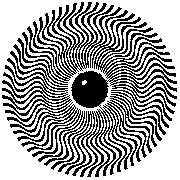 Moving or Non-moving fan? |
Stare at the image and then look at the white/light area below. Do you or don't you see an after-image? |
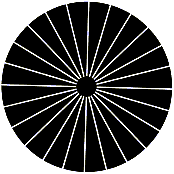 Moving or Non-moving spokes? |
Do you or don't you see an after-image effect of the image on the left in the white/light area below? |
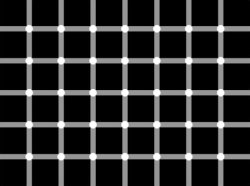 |
Are there or are there not blinking dots? |
 |
Are there four or more elephant legs? |
 |
Do you or don't you see the word lift? |
 |
Does the area around the dot shrink or not after staring at the center dot for awhile? |
Source for the last four images:
http://www.kingssportscamps.com/kids/funstuff.php?SID
While many people have seen and tried out the after-image effect by using various black/white and colored images in varying arrangements such as by staring at the spokes of a moving bicycle or stage-coach on an old western motion picture, they customarily do not consider how such an effect may be reproduced by viewing very bright objects against a dark colored background. Those who do, simply shrug off such an observation with little further regard than as another example of a visual anomaly (or in some cases, indicate silently to themselves that this is a unique ability all their own). Yet, if we apply this understanding of after-image effects to such objects as the Sun, Moon, and Stars, we can come up with some considerations as to how the development of life may have been affected in its processes during the impressionable, sensitive, and malleable stages of growth billions of years ago, and is still going on today in some fashion.
The usage of time-lapsed photography gives us some indication of the environmental conditions early biological life processes were subjected to many billions of years ago when the Earth was spinning faster. Early biological processes would have been subjected to a repeating triangular image of the Sun, Moon (and stars) for long periods of time. It should be no wonder that we find this image being expressed in a variety of ways by different organisms, within the limitations of their physical/mental ability to do so. If we humans of today can get sun-burned, it's not too difficult to appreciate how such a triangular image could have been "branded" on the sensitive, impressionable, (highly "suggestive") "hide" of our early biological beginnings. (As a child, I would frequently encounter the image of standing on a fast spinning Earth and watching the Sun, Moon, and Stars whisk by in a flickering (blinking) motion.
On page 80 of the 10/97 issue of Natural History magazine is a picture of the Moon in eclipse, though it could just as easily be a picture of the Sun. I inverted the picture in order to represent the entire image of the pathway which shows a distinctive triangular form. Because such an image would have occurred with more frequency and intensity during the early stages of biological development, it is easy to consider the possibility that an after-image effect has occurred in "light" of the fact that many variations of triangular structures crop-up:
- Pyramidal forms in Egypt, Asia, North America, Meso-America, etc...
- Mounds in "higher" termites.
- Fins in various aquatic life forms.
- V-shaped flight formations of migrating birds.
- V-shaped engine blocks. Clothes hangers.
- Cleavage, crotch and clothing "concealed" butt crack portrayals of humans.
- The desired V-tapered and "hourglass" (overlapping triangles) shapes in human physiques.
- Pyramidal hairdos of women during various eras of fashion.
- Usage of Triangle-shaped Christmas trees.
- Triangle tips of rockets, bullets, arrows, etc...
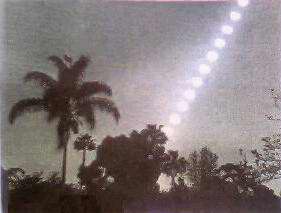 |
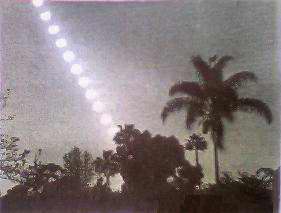 |
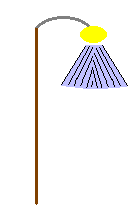
By looking (some people may have to stare for a longer period of time) at the above image as a whole for a few moments and then divert your gaze to the white/light area below, do you get a faint impression of the triangular image? This faint triangle impression is what I see when I look at street-lights in the morning after they have been turned off by the photo-electric cell. There is a greyish- looking triangular after-image emanating which looks like a bunch of triangles dangling from lamp posts as I drive down a street. I see the image even though I do not stare into the street-lights when they are on. It is like an after-glow of sorts that reminds me of the glow I sometimes see surrounding people, plants, etc...
The above picture clearly shows that there is a triangular pathway. By staring into the images of triangular light and then diverting one's glance to the dark areas (to momentarily mimic the episodic moments of day time/night time, we may see a dark referential after-image due to the coloring arrangement in the above images. However, in an actual life setting such as the bright background coupled with a brighter Sun, and then look at a dark background (just as biological life was exposed to during the evolving day/night sequence), we can see a distinct light image. If we momentarily look at a source of bright light, or attend to an extended view of a weaker light source such as a TV, and then look at a dark spot, (such as we do when we turn a TV off in a darkened room), we can see variations of the brighter solar image.
The usage of time-lapsed photography to capture the slanted (triangular) path gives a good indication of how a fast spinning Earth during life's pristine biological development (billions of years ago) helped to create different environmental conditions under which biological variations took place due to differences in exposure with respect to differing micro-climates such as a deep ocean, desert floor, or mountain top. Some three and a half to four billion years ago, the Earth's rate of daily revolution was considerably faster than our present 24-hour rate. This accelerated rate would have caused the triangular image to occur more frequently during life's sensitive and impressionable development. If we humans of today can get sun-burned, it's not too difficult to appreciate how such a triangular image could have been "branded" on the "hide" of our early biological beginnings. But let us now consider what other effects could have been produced by an accelerated spinning Earth.
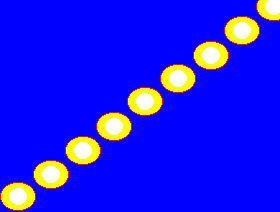 |
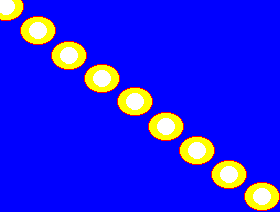 |
In another variation of the solar triangular image, after-image effects readily occur without too much need for diverting one's gaze after staring at the above images for a short period. The after-image effect may not only have influenced a triangular "after-image behavioral repertoire" that is exhibited in a variety of ways with respect to a given species in question, but also influenced biological development in more subtle ways to exhibit such forms as circular-like, linear-like, and a 1- 2- 3 maturational development sequence.
Although images used to test for color blindness are not customarily looked upon as optical illusions (unless of course you are adamant about seeing/not seeing something that others do), they none-the-less are another example of a two-patterned orientation requiring a participant to agree or disagree for the presence of a number existing amongst the dots configurations:
| Ishihara Test for Color
Blindness Do you see numbers or just dots in the images below? | ||||
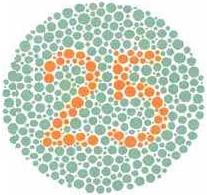 |
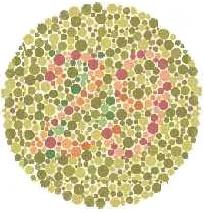 | |||
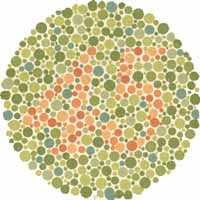 |
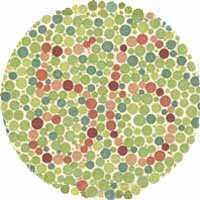 | |||
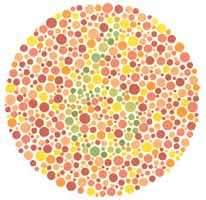 |
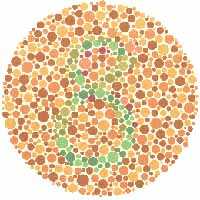 | |||
| Type of Vision | Top row | Center row | Bottom row | |
| Normal Left Eye- | 25 | 45 | 6 | |
| Normal Right Eye- | 29 | 56 | 8 | |
| Red/Green Blindness Left Eye- | 25 | Spots | Spots | |
| Red/Green Blindness Right Eye- | Spots | 56 | Spots | |
Another interesting color blindness test is below | ||||
| The test to the right is simpler. People with normal color vision will see a 5. People with Red/Green blindness will see a 2. (Red/Green color blindness is most common.) |
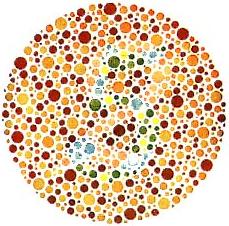 |
|||
http://www.toledo-bend.com/colorblind/Ishihara.html
Page Update: Tuesday, 06-Dec-2016... 10:11 AM
Your Questions, Comments or Additional Information are welcomed:
Herb O. Buckland
herbobuckland@hotmail.com